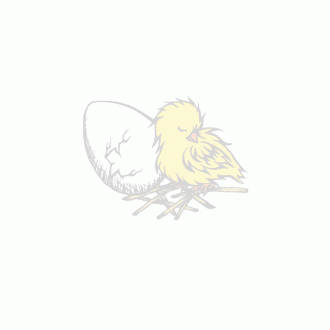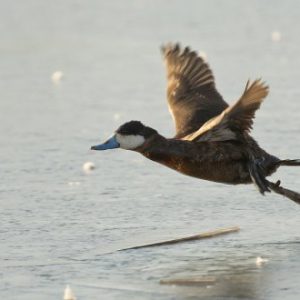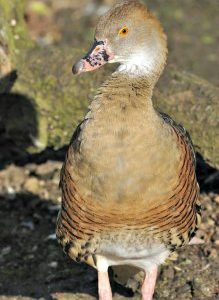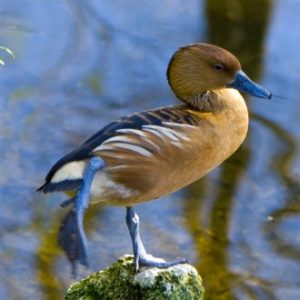Cairina moschata
Note – Wild Muscovy Ducks are different from Feral Muscovy Ducks. In states such as Florida, domestic Muscovy Ducks have escaped or been released into the wild, where they have quickly become a nuisance and are considered an invasive species. Muscovy Ducks must be kept in a secure enclosure. These birds are not for releasing into the wild.
Wild Muscovy Ducks are quite rare to find. They have many similarities to the domestic Muscovies and are indeed their ancestors. Wild Muscovy Ducks look very different from their domestic counterparts. Domestic Muscovies have been bred for centuries starting with pre-Incan South American cultures. They are heavier and come in a wide range of colors, and are mostly raised for meat.
The Wild Muscovy Duck is lighter in weight and is mostly black with some white markings. Wild Muscovy Ducks have blackish gray bills with some lighter colors and patches. The feet and legs are also black. Unlike domestic Muscovies, Wild Muscovy Ducks lack the dramatic bright red caruncles over the face and head, although they do have smaller caruncles and black-colored skin patches. White Markings along with markings on the bill and caruncles on the face vary from bird to bird, which does make individuals easier to identify. The white patches usually develop after a couple of years of age.
Male Wild Muscovy Ducks are almost twice the size of females. And males sport more caruncles on their faces. The typical male Wild Muscovy Duck would have a black mask of skin and will develop a variety of ridges and bumps as well as an outline of a red-colored wart-like bump. These enamoring faces also usually include a knobby protrusion over the base of the bill. Females will have a flatter and smoother mask of black or red.
Muscovies are perching ducks – their closest relative is the Wood Duck. Wild Muscovies have not been ancestors to any other domestic breed of duck. When cross-bred to a Mallard, or other mallard-derived breeds, the offspring are sterile. The Muscovy is an extremely unusual duck.
Range: Wild Muscovy Ducks are native to Central and South America, ranging from coastal Mexico, south into South America, reaching to Peru in the west and down into Uruguay and northern Argentina in the south and east. They do not migrate., another thing that distinguishes them from most other duck species.
Habitat: Wild Muscovy Ducks are mostly found around forested fresh water and wetlands with large trees for roosting, nesting, and perching. They spend most of their day up in the trees and come down to forage at dawn and dusk. They are wary birds and tend to live in small family groups.
Status in the Wild: Although populations are strong, the main concern would be the mixing of wild populations with domestic. Wild Muscovy Ducks have been studied very little.
Status in Aviculture: True Wild Muscovy Ducks are hard to find, but much respected in avian circles. The Muscovy duck has been domesticated for centuries and are popular because they have stronger-tasting meat with less fattiness than the usual domestic ducks descended from the mallard. Muscovy Ducks are also liked because they are less noisy than other ducks.
Breeding: Wild Muscovy Ducks are polygamous which is atypical of most duck species, which are monogamous. They will need a nest placed off the ground.
Lifespan: Wild Muscovy Ducks in captivity have been known to live between 10 and 20 years old.
Size: Wild Muscovy Ducks can range dramatically in size. They can measure between 26 and 33 inches in length. The wingspan is between 54 and 60 inches. Males can weigh between 6.5 and 9 pounds. Females are smaller and weigh between 3.25 and 4.75 pounds.
Housing Requirements: Although the Wild Muscovy Duck is from a tropical climate, they are very hardy birds and adapt well to cooler locations as long as the temperature stays above 8-10 degrees F. They will need access to water and perching locations. Wild Muscovy Ducks are strong fliers and have strong claws for climbing. They will need a roofed enclosure to keep them from escaping. They are easy to keep and manage.
Diet: Wild Muscovy Ducks are very opportunistic feeders, eating anything they find from vegetable matter to small mammals. They seem to prefer foraging in shallow water especially on flooded vegetation. A quality waterfowl diet would be fine although they would do well with supplemental vegetable matter.
Miscellaneous Notes: When a Muscovy Duck is crossed with a Mallard, the hybrid offspring are called Mulards or Mule Ducks because they are sterile.
Another cool fact – Oscillococcinum, a homeopathic preparation for preventing the flu manufactured by Boiron, is made from Muscovy duck liver and heart.




